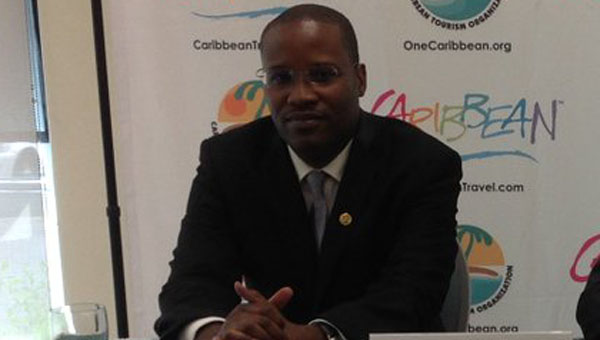BRIDGETOWN, Barbados, February 13, 2019 (CMC) – Tourist arrivals to the Caribbean hit a record high, last year, despite some destinations being severely impacted by hurricanes that swept through the region in 2017, according to figures released, today, by the Barbados-based Caribbean Tourism Organisation (CTO).
“With a strong performance during the last four months of 2018, including a robust showing by countries impacted by the 2017 hurricanes, the evidence suggests that Caribbean tourism is on the upswing,” CTO acting Director of Research and Information Technology, Ryan Skeete, told reporters.
Delivering the CTO’s annual Caribbean Tourism Performance Report 2018 & Outlook for 2019, Skeete said the outlook for Caribbean tourism in 2019, is cautiously optimistic.
“Global demand for international travel is expected to remain strong, underpinned by healthy economic activity. Global economic growth is expected to continue, though at a slower rate, and oil prices are expected to remain similar to 2018 prices. Additionally, improved air connectivity should help to boost arrivals,” he announced.
“Of course, we must recognise that there are significant headwinds to navigate. These include, but are not limited to, the outcome of the Brexit negotiations, the on-going trade war between the US and China and potential extreme weather events in the destinations and marketplaces.
“Consequently, we are projecting that tourist arrivals will increase by, between six and seven percent in 2019, as the damaged infrastructure in the hurricane-impacted destinations returns to capacity. Similarly, cruise arrivals should expand by a further four to five percent,” Skeete predicted.
He told reporters, having registered declines during the first eight months of last year, signs of a rebound emerged in September, when the region recorded a three percent increase in visitor arrivals.
He said the numbers in October confirmed the recovery, with a healthy 11.8 percent growth, and by the end of the year tourist arrivals in the last four months were up 9.8 percent.
“Even the destinations that were severely impacted by the 2017 hurricanes, despite registering overall double-digit declines last year, experienced a significant turnaround during the last four months, registering triple-digit increases during this period.
“Overall, the Caribbean received 29.9 million tourist visits in 2018, the second highest on record, surpassed only by the 30.6 million, who visited in 2017,” he revealed.
However, last year’s arrivals numbers represented a 2.3 percent fall, a much better performance than the three to four percent falloff that tourism officials had anticipated.
“This was the first decline in annual tourist arrivals in nine years, and with global growth in international trips increasing by 5.6 percent, the Caribbean market share of global visits, in 2018, shrank by 0.2 percentage points, to 2.1 percent of the market,” the acting Research Director observed.
Skeete told reporters that total visitor spending also declined, slightly, by approximately one percent, to US$38.3 billion, although tourists spent slightly more per trip than they did in 2017, with the spending being US$1,177 per trip, compared to US$1,171 in 2017.
Among the destinations, tourist arrivals showed uneven growth. Several countries reported double-digit increases in 2018, such as Guyana (15.9 percent), Belize (14.6 percent), the Cayman Islands (10.7 percent), The Bahamas (10.5 percent) and Grenada (10 percent), while the hurricane-impacted countries recorded double-digit declines.
He said that the contributing factors to the excellent performances in the countries not impacted by the hurricanes, included sustained targeted marketing, upgraded tourism infrastructure, additional rooms and enhanced airlift.
Regarding the major Caribbean sub-regions, the US territories, the Organisation of Eastern Caribbean States (OECS), and the Dutch Caribbean reported declines of 29, six and seven percent respectively.
In contrast, the grouping dubbed “Other Caribbean”, comprising Cancun, Cozumel, Cuba, the Dominican Republic, Haiti and Suriname, which accounts for almost half of all arrivals to the region, recorded an increase of 1.8 percent, while the Caribbean Community (CARICOM) sub-region recorded an increase of 4.5 percent.
The figures show that while the United States remains the Caribbean’s largest market, it was Canada that outperformed all other markets, last year, with 5.7 percent growth or 3.9 million visits.
Skeete said that this was due to its strong economic performance and increased seat capacity to the region.
He added that intra-regional travel had its best performance ever, reaching a record two million visits, representing a strong 5.3 percent rise. It was followed closely by South America, which produced 1.9 million visits, representing a 3.6 percent increase.
Arrivals from Europe improved modestly by an estimated 1.3 percent, partially reflecting the fact that more United Kingdom tourists were switching to domestic holidays, attributed to the continuing Brexit negotiations, the related uncertainties and a weaker pound. UK arrivals remained flat at an estimated 1.3 million.
On the other hand, the 13.9 million American tourist visits, last year, represented a 6.3 percent fall. This was due mainly to steep declines in arrivals to popular destinations impacted by the hurricanes, such as Puerto Rico, which was down by 45.6 percent, and St. Maarten, which fell by 79 percent.
However, the rebound that the region experienced during the September to December period last year, was quite evident in the US market, which saw fourth-quarter growth of 28 percent.
Regarding hotel occupancy, the figures show that in line with the overall decrease in arrivals to the region, hotel occupancy fell by 0.8 percentage points, according to the US-based STR Inc that tracks supply and demand data for the hotel industry. However, the average daily room rates increased by 1.7 percent to US$207.61, while revenue per available room grew by 0.6 percent to US$135.46.
Air capacity in the region for 2018 decreased by 3.4 percent, while the number of flights declined by 4.3 percent.
However, as with arrivals, there was a reversal of these numbers in the fourth quarter, with seat capacity rising by 5.3 percent, while frequency grew by 5.2 percent, the CTO added.
 Pride News Canada's Leader In African Canadian & Caribbean News, Views & Lifestyle
Pride News Canada's Leader In African Canadian & Caribbean News, Views & Lifestyle





